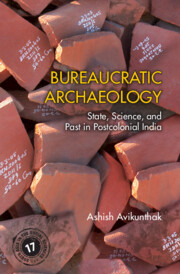Book contents
- Frontmatter
- Dedication
- Contents
- List of Figures
- Preface
- Acknowledgments
- Note on Transliteration
- List of Abbreviations
- 1 Anthropology of Archaeology
- 2 The Making of the Indus–Saraswati Civilization
- 3 Bureaucratic Hierarchy in the ASI
- 4 Spatial Formation of the Archaeological Field
- 5 Epistemological Formation of the Archaeological Site
- 6 Theory of Archaeological Excavation
- 7 Making of the Archaeological Artifact
- 8 Performance of Archaeological Representations
- 9 The Absent Excavation Reports
- Conclusion
- Bibliography
- Index
8 - Performance of Archaeological Representations
Published online by Cambridge University Press: 20 August 2021
- Frontmatter
- Dedication
- Contents
- List of Figures
- Preface
- Acknowledgments
- Note on Transliteration
- List of Abbreviations
- 1 Anthropology of Archaeology
- 2 The Making of the Indus–Saraswati Civilization
- 3 Bureaucratic Hierarchy in the ASI
- 4 Spatial Formation of the Archaeological Field
- 5 Epistemological Formation of the Archaeological Site
- 6 Theory of Archaeological Excavation
- 7 Making of the Archaeological Artifact
- 8 Performance of Archaeological Representations
- 9 The Absent Excavation Reports
- Conclusion
- Bibliography
- Index
Summary
It was a big day for the archaeologists at Dholavira. The chief minister of Gujarat and a national level politician were going to visit the site. “The nearest we have ever got to such a darshan (divine glimpse) of a politician was when Rajiv Gandhi visited us. He came to Rapar during an election campaign many years ago,” remarked a senior laborer. We were in the site director's mud hut in Dholavira—students, assistant archaeologists (AAs), technical staff, the director, along with the superintending archaeologist (SA) of the Vadodara Circle and his staff, sitting on red, yellow, and white molded plastic chairs, sipping endless cups of sweet tea and munching on Parle biscuits. We had been waiting since early morning. It was noon now and there was still no sign of the dignitaries. It was getting hot and the desert sun was blazing on a winter December day. The SA of the Vadodara Circle, drying the perspiration over his forehead with a white handkerchief, complained in muted annoyance: “These VVIPs are never on time. There is no difference between a film star and these politicians. They are always late.” Soon a flurry of anecdotes about different VIP visits was flying back and forth across the plastic table. Stories of conceited petty politicians, petulant district magistrates, nondescript members of the Legislative Assembly (MLAs), imperious former members of Parliament (MPs), arrogant district police commissioners, complacent secretaries of the state, their haughty wives, frivolous daughters, and brash relatives were recounted with a familiar candor, amusement, and scorn. “Everyone wants to see an archaeological excavation. They think it is a circus or a zoo. Too much of Discovery Channel and National Geographic Channel has made them think they will see gold jewelry and mummies here,” remarked a senior AA. “For their touristy fun we have to sweat,” he complained. “It is not just a waste of our time. It is also a sheer waste of money and energy of the nation.” No one raised an eyebrow at this outburst; we were all tired from waiting for the VVIPs.
It was after almost another hour of “time-pass” (Craig 2010) that we heard the sound we were all waiting for—the distant hum of army helicopters—the chief minister and his entourage had arrived.
- Type
- Chapter
- Information
- Bureaucratic ArchaeologyState, Science, and Past in Postcolonial India, pp. 205 - 226Publisher: Cambridge University PressPrint publication year: 2021

